
Ants are eusocial insects of the family Formicidae and, along with the related wasps and bees, belong to the order Hymenoptera. Ants appear in the fossil record across the globe in considerable diversity during the latest Early Cretaceous and early Late Cretaceous, suggesting an earlier origin. Ants evolved from vespoid wasp ancestors in the Cretaceous period, and diversified after the rise of flowering plants. More than 13,800 of an estimated total of 22,000 species have been classified. They are easily identified by their elbowed antennae and the distinctive node-like structure that forms their slender waists.
Most ants are capable of biting, stinging, and spraying irritant chemicals. However, only relatively few species can harm humans; among which some can cause significant injury or, in rare cases, death. Like wasps, individual ants are capable of stinging multiple times as they do not lose their stingers.
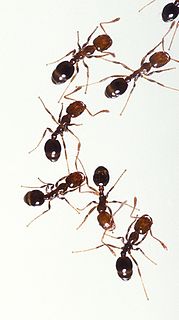
Fire ants are several species of ants in the genus Solenopsis. They are, however, only a minority in the genus, which includes over 200 species of Solenopsis worldwide. Solenopsis are stinging ants, and most of their common names reflect this, for example, ginger ants and tropical fire ants. Many species also are called red ants because of their light brown color, though species of ants in many other genera are similarly named for similar reasons. Examples include Myrmica rubra and Pogonomyrmex barbatus.

The red imported fire ant, also known as the fire ant or RIFA, is a species of ant native to South America. A member of the genus Solenopsis in the subfamily Myrmicinae, it was described by Swiss entomologist Felix Santschi as a variant in 1916. Its current specific name invicta was given to the ant in 1972 as a separate species. However, the variant and species were the same ant, and the name was preserved due to its wide use. Though South American in origin, the red imported fire ant has been accidentally introduced in Australia, New Zealand, several Asian and Caribbean countries, and the United States. The red imported fire ant is polymorphic, as workers appear in different shapes and sizes. The ant's colours are red and somewhat yellowish with a brown or black gaster, but males are completely black. Red imported fire ants are dominant in altered areas and live in a wide variety of habitats. They can be found in rain forests, disturbed areas, deserts, grasslands, alongside roads and buildings, and in electrical equipment. Colonies form large mounds constructed from soil with no visible entrances because foraging tunnels are built and workers emerge far away from the nest.

The eastern fence lizard is a medium-sized species of lizard in the family Phrynosomatidae. The species is found along forest edges, rock piles, and rotting logs or stumps in the eastern United States. It is sometimes referred to as the prairie lizard, fence swift, gray lizard, northern fence lizard or pine lizard. It is also referred to colloquially as the horn-billed lizard.
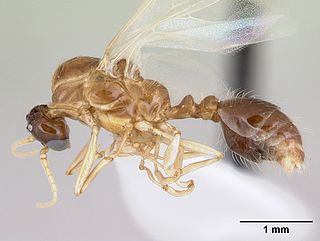
Solenopsis daguerrei is a species of parasitic ants native to Argentina and Uruguay . The young queens of the species invade the nests of other species, such as the red imported fire ant (RIFA). This is made possible by the fact that the S. daguerrei queen produces pheromones which are very similar to those produced by the queens of the host species. The young queen finds a queen of the host species and latches onto it, eating the food intended for the host queen and slowly killing it. The S. daguerrei queen then begins laying eggs. These are taken care of by the host ants, sometimes preferentially to their own brood. S. daguerrei only produce winged virgin queens and males. No workers are needed, since these are provided by the host species. The winged ants fly off to mate and invade new colonies.

Nuptial flight is an important phase in the reproduction of most ant, termite, and some bee species. It is also observed in some fly species, such as Rhamphomyia longicauda.

Solenopsis molesta is the best known species of Solenopsisthief ants. They get their names from their habit of nesting close to other ant nests, from which they steal food. They are also called grease ants because they are attracted to grease. Nuptial flight in this species occur from late July through early fall.

Solenopsis saevissima, commonly known in Brazil as formiga de fogo, formiga-vermelha, or formiga-lava-pes, is one of more than 185 species in the genus Solenopsis. It, along with 13 other species, is also a member of the Solenopsis saevissima species group which are popularly known as fire ants.

The red imported fire ant, or simply RIFA, is one of over 280 species in the widespread genus Solenopsis. It is native to South America but it has become both a pest and a health hazard in the southern United States as well as a number of other countries.
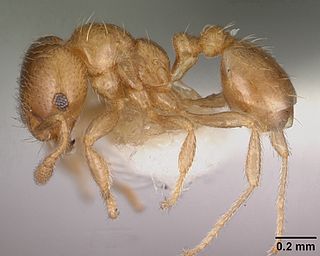
Diplomorium is a genus of ants in the subfamily Myrmicinae containing the single species Diplomorium longipenne. The genus is known only from females and workers from South Africa, males remain unknown. Little is known about their biology, except that they nest under stones. They have been found nesting at the same location as Messor capensis, however, it is not known whether this was coincidence or if the species have a relation with each other.
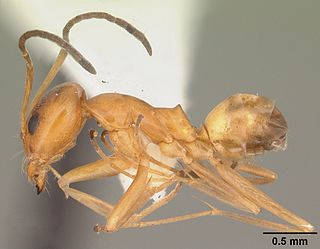
Dorymyrmex bureni also known as pyramid ant is a species of ant in the genus Dorymyrmex. Described by Trager in 1988, the species is endemic to the United States and Mexico. Pyramid ants are medium-sized ants, ranging from 2–4 mm. They are light orange in color and fast moving. Unlike other ants in the area like red imported fire ants, this species is not aggressive towards humans. The workers have a foul smelling coconut odor when crushed. Dorymyrmex bureni hunt living insects, even other winged ants. They also search for sap-sucking insects from which they collect honeydew. On the head of these ants are curved hairs, used for transporting beads of damp sand. Colonies are small. Nests usually have a single entrance with a mound of sand shaped like a crater. Dorymyrmex bureni prefer sandy soil. This species of ant is not an indoor pest, and pesticides should not be used. They are found throughout Florida.
The toxicology of fire ant venom is relatively well studied. The venom plays a central role in the biology of Red imported fire ants, such as in capturing prey, and in defending itself from competitors, assailants, and diseases. Some 14 million people are stung annually in the United States, suffering reactions that vary from mild discomfort, to pustule formation, swelling, and in rare cases, systemic reactions followed by anaphylactic shock. Fire ant venoms are mainly composed (>95%) of a complex mixture of insoluble alkaloids added to a watery solution of toxic proteins. For the Red imported fire ant Solenopsis invicta Buren there are currently 46 described proteins, of which four are well-characterised as potent allergens.

Solenopsis texana, the thief ant , is a species of ant in the family Formicidae.
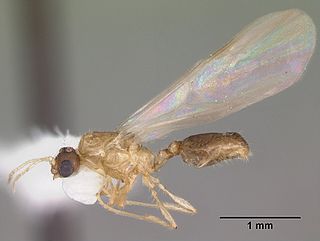
Solenopsis carolinensis, the thief ant, is a species of ant in the family Formicidae.

Solenopsis aurea, also commonly called the golden fire ant, is a species of ant native to the southwestern United States and Northern Mexico. Workers have a pale golden coloration with occasional brown spots.
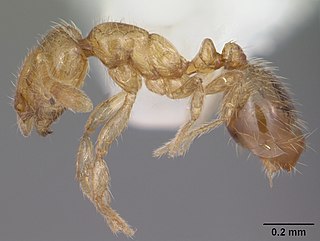
Solenopsis abdita is a species of thief ant in the Solenopsis molesta complex, first described in 1989 in Florida. It is native to Florida but may be found in the surrounding states, though this is not confirmed. This species can be hard to differentiate from Solenopsis texana and S. carolinensis, but there are a few minor differences, such as having a longer scape and a wider petiole. Thus, the main method used to distinguish these species primarily uses queens and males, though unfortunately usually only workers are collected, making it difficult to correctly identify this species. S. molesta is known to nest in rotten wood in pine–oak forests, and workers have been collected from leaf litter in said forests.
Solenopsis altinodis is a species of ant first described by Forel in 1912. Workers are bi-colored with a brown gaster and a yellow head and thorax. This species has been found in Costa Rica, Colombia, Guiana, Trinidad and Venezuela. This species is often confused with Solenopsis bicolor because of the similar coloring.
Pseudacteon tricuspis is a parasitic phorid fly that decapitates its host, the imported Solenopsis invicta fire ant. There are over 70 described species within the Pseudacteon genus, which parasitize a variety of ant species. However, P. tricuspis is very specific to its host ant and will not attack other native ant species, making it a good biological control against the fire ant. P. tricuspis was also introduced into the United States for this purpose. Aside from the United States, P. tricuspis has also been found in South America, Europe, and Asia. Female P. tricuspis deposit their eggs directly into the fire ant host. Deposition into the ant host determines the sex of the egg, which grows within the host until adulthood, killing and decapitating the host in the process. Interestingly, P. tricuspis has a male-biased sex ratio, where the males are smaller than the females.














